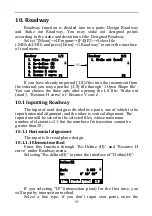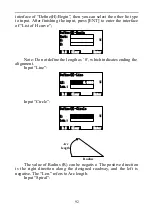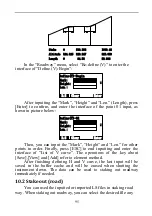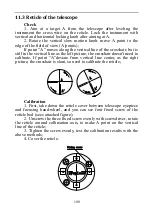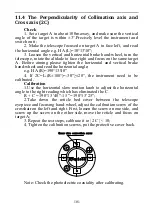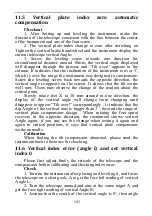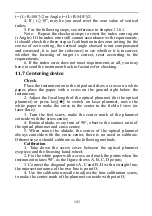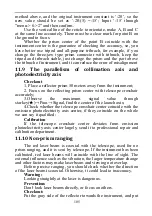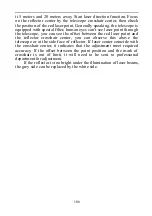
102
11.5
Vertical
plate
index
zero
automatic
compensation
Checkout
1. After Setting up and leveling the instrument, make the
direction of the telescope consistent with the line between the center
of the instrument and any of the foot screw;
2. The vertical plate index change to zero after switching on
Tighten the vertical brake hand-wheel and the instrument display the
current telescope vertical Angle;
3. Screw the leveling screw towards one direction for
circumferential distance around 10mm, the vertical angle displayed
will disappear through the process and ‗Tilt over!‘ appears to the
column. It indicates that the inclination of the instrument is over 3′,
which is over the range the instrument was designed to compensate.
Screw the leveling screw back towards the opposite direction, the
vertical angle re-appears on the screen. It shows that the tilt works
well now. Users may observe the change of the readout about the
critical point.
Slowly rotate feet X to 10 mm around in one direction, the
display of the vertical angle will change from changing until
disappear to appear "Tilt over!" correspondingly , it indicate that the
dip Angle of the vertical axis is bigger than 3 ', beyond the range of
vertical plate compensator design . When rotating the feet spiral
recovery in the opposite direction, the instrument shows vertical
Angle again, if you can see the change when testing it again and
again in critical positions, it says that vertical plate compensator
works normally.
Calibration
When finding the tilt compensator abnormal, please send the
instrument back to factories for checking.
11.6 Vertical index error (angle i) and set vertical
index 0
Please first adjust finely the reticule of the telescope and the
compensator before calibrating and checking index error.
Check
1. Turn on the instrument after placing and leveling it, and focus
the telescope on a clear goals .A to get the face left reading of vertical
Angle L;
2. Turn the telescope around and aim at the same target A and
get the face right reading of vertical Angle R;
3. Assume that the zenith of the vertical angle is 0°, then angle




